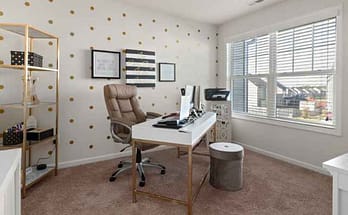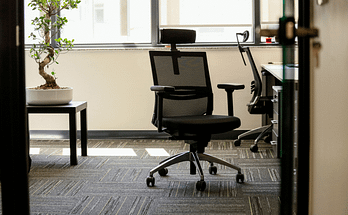You’ve set up your home office and are ready to work. But where are you going to do it? If you’re lucky, your home has a room that’s big enough to house a desk—and maybe even some storage space for your printer and other supplies. But if not, you might need to improvise with the help of some clever furniture placement or just a bit of reorganizing. No matter what type of space you have, there are several factors to consider when choosing a desk:
Identify Your Workstation Type
Identifying your workstation type is the first step to finding the perfect desk for you. There are three types of workstation arrangements that most people fall into: single-person, dual-person, and team.
Single-person Workstation. You’re likely to have a simple desk setup if you work alone in an office or at home, with room for a monitor and a standard desktop computer (or laptop, if you prefer). In this case, your space must be both functional and comfortable. Of course, you want to feel productive at all times, so make sure it has enough room for everything you need – files or decorations on top of the desk itself!
Dual-Person Workstation. When two people share one workspace (whether in an office or home), there needs to be some compromise between personalization and efficiency when choosing furniture options such as desks or chairs, especially since they may not always agree on what each prefers! It is best to use modular pieces so that everyone’s needs are accommodated without taking up too much space in any one space. For example, two monitors connected instead of stacking them together, and two separate keyboards and mice up front instead of being clumped together behind us all day long like a science experiment gone wrong.
Focus on Your Work Style
The first thing you should consider is your work style. Do you prefer a standing or sitting desk? How do you like to interact with your colleagues? Do you prefer privacy when working or more social contact?
The answers to these questions will help narrow down the options and ultimately lead to the best home office desk for your needs. For example, if you’re naturally an introvert who likes working alone in a quiet environment, then a standing desk may be perfect for your needs. But if talking about ideas with others drives your creativity and productivity, then perhaps a sitting configuration that gives everyone easy access would be better suited for how you work best.
Consider Desk Material
You’ll want to consider the material of your desk. There are a few options to choose from:
- Wooden desks are the most durable but heavier and more difficult to move than other types.
- Metal desks tend to be lighter than wooden ones, and they’re easier to move around if you need extra space or want a different layout at some point. However, metal can be damaged by knocks and dings more easily than wood; it may also scratch easily and dent when dropped onto hard surfaces like concrete floors or tile floors with lots of grout lines between tiles (think linoleum). It’s also important not to place anything heavy on top of metal desks because they might bend under pressure!
- Plastic desks are lightweight enough to move them around without difficulty—which makes sense since they don’t have any real structural integrity anyway!
Placement / Location
- Choose a comfortable location. The ideal workstation should have ample room for your body to move about and plenty of room for your computer and other equipment. If you do not have enough space in your home office, consider clearing out the closet or storage space.
- Consider the room layout. Avoid placing the desk near windows or doors because they can let in too much light or noise from outside traffic. You may be tempted to place it near heating vents and air conditioning vents to keep cool in hot months and warm in cold months. However, this choice can lead to neck strain and headaches when you use your computer all day, especially if you sit comfortably at a distance from these vents while working on your project.
- Avoid placing the desk directly against walls; doing so will cause distractions with lighting coming through windows behind you and distracting noises entering your ears (including those produced by fans).
Size of the desk
The size of a home office may be determined by the space available in your home, but it also can be influenced by the type of work you do. For example, consider a large desk that provides plenty of surface space if you need room for a lot of equipment and supplies. In addition, it will allow you to spread all your materials and keep them within easy reach when working on projects. On the other hand, if you work from home primarily as a writer or graphic designer—and don’t need much more than a computer plus some basic office supplies—then a smaller desk may be sufficient for your needs.
Height
There are two general heights to consider when choosing a home office desk: standard and low. Standard desks range from 30 to 36 inches high; these are the most common types in schools and offices. On the other hand, low desks are typically around 24 inches in height. They’re commonly used as computer workstations because they allow users to sit comfortably while typing and looking at their screens without straining their necks or backs.
Depths
The depth of a home office desk is another important consideration when choosing furniture. The standard desk depth is 30 inches; however, you can find models as shallow as 24 inches or as deep as 48 inches. If the desk will be used primarily for typing and working on computers, then a shallower model will work fine; however, if you plan to use your desk for other purposes, such as crafting or painting.
Width
The width of a home office desk is another important consideration. You can find desks in various widths, from small 24-inch models to large workstations measuring 60 inches or more. If you plan to use your desk as a workstation, consider purchasing a model at least 48 inches wide. It will give you plenty of space for placing computers and other equipment on the desk. On the other hand, if your home office only needs a smaller table or surface area, then look for desks that measure 30 inches or less in width. The height of a home office desk is also important to consider when shopping for furniture.
What shape desk is best for the space?
While there’s no right or wrong answer to what shape your desk should be, it will depend on the space you’ve got available. For example, a round or oval table might be just what you need if you’re working in a small area. These are great for small rooms because they take up less room than their square counterparts. On the other hand, if you have more space to work with and want an L-shaped desk that opens up into a circle when the two sides meet, this is another option worth considering. Finally, if you need something even larger (but not as big as some industrial-sized desks), you might consider an expandable corner unit, which can be easily tucked away when not used.
You may want to consider getting one made from lighter materials such as bamboo rather than solid wood if mobility is crucial for whatever reason (perhaps it has to be moved a lot). Also, it will be easier for those unable to lift heavy things because of their aging or disabilities.
Do you need storage, too?
It would help if you also thought about how much storage you need. If you’re a writer, artist, or performer with many materials for your work spread out on your desk, more storage options will be helpful. However, if you don’t have much stuff that needs to be stored, this may not matter as much to you.
Other factors that come into play when choosing an office desk besides the amount of storage space and the size of the work surface are:
- Consider how much time per day or week is spent sitting at this desk (e.g., 30 hours/week vs. 15 hours/week). Choosing something comfortable enough is important so long hours aren’t spent feeling uncomfortable!
What type of chair do you need?
The chair you choose for your home office will greatly impact your comfort and productivity. Here are six things to look for when shopping for a good desk chair:
- Adjustability. The seat height, back angle, and armrests should all be adjustable to find the best position for your body’s unique dimensions.
- Armrests. Not all chairs have armrests, but those that do offer more support and lower the risk of repetitive stress injuries like carpal tunnel syndrome. When choosing an armless chair, make sure there’s another way to prop up your arms while working (a footrest or ottoman).
- Back support. The best desks are designed with lumbar support in mind—it should align with the small of your back when seated so that it supports this natural curve while keeping your spine aligned properly when sitting at a computer keyboard or desk all day long! If possible, buy two chairs: one dedicated solely towards work; this way, each part is supported, preventing straining any single area over time.
Alternate Options
- Standing Desks: Standing desks are a great alternative to sitting and have been shown to reduce muscle tension and improve posture.
- Laptop Stands: If you prefer to work with a laptop on a desk, consider getting an adjustable laptop stand instead of a separate keyboard and mouse. Suppose your laptop has USB ports that can be used for the purpose.
- Treadmill Desks: If you like walking while working, consider investing in a treadmill desk instead of just standing at your regular desk.
Make sure you pick the right desk for your space and workflow.
Before shopping for a desk, think about what you need it for. If you work from home or have an office in your house, there are a few questions to ask yourself:
- How much space do I have?
- Do I need storage space?
- What size desk will fit my needs and workflow?
If the answers are not immediately obvious to you, here’s how to figure them out.
Conclusion
The key to selecting the right home office desk is to make sure that it fits your space and workflow. You should also consider how much storage space you need and whether or not your workplace has enough room for dual-purpose furniture like tables that can be used as desks.



